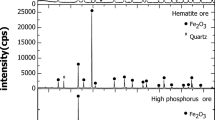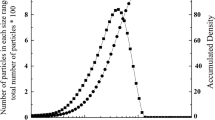Abstract
Reduction of hematite pellets using H2-CO mixtures with a wide range of H2/CO by molar (1:0, 3:1, 1:1, 1:3, and 0:1) at different reducing temperatures (1073, 1173, and 1273 K) was conducted in a program reducing furnace. Based on an unreacted core model, the effective diffusion coefficient and reaction rate constant in several cases were determined, and then the rate-control step and transition were analyzed. In the results, the effective diffusion coefficient and reaction rate constant increase with the rise in temperature or hydrogen content. Reduction of iron oxide pellets using an H2-CO mixture is a compound control system; the reaction rate is dominated by chemical reaction at the very beginning, competition during the reduction process subsequently, and internal gas diffusion at the end. At low hydrogen content, increasing temperature takes the transition point of the rate-control step to a high reduction degree, but at high hydrogen content, the effect of temperature on the transition point weakens.
Similar content being viewed by others
References
S.R. Zhang and H. Yin, The trends of ironmaking industry and challenge to Chinese blast furnace ironmaking in the 21st century, China Metall., 19(2009), No. 9, p. 1.
Y. Kato, Carbon recycling for reduction of carbon dioxide emission from iron-making process, ISIJ Int., 50(2010), No. 1, p. 181.
C.H. Rhee, J.Y. Kim, K. Han, C.K. Ahn, and H.D. Chun, Process analysis for ammonia-based CO2 capture in ironmaking industry, Energy Procedia, 4(2011), p. 1486.
H.K. Pinegar, M.S. Moats, and H.Y. Sohn, Process simulation and economic feasibility analysis for a hydrogen-based novel suspension ironmaking technology, Steel Res. Int., 82(2011), No. 8, p. 951.
H.T. Wang and H.Y. Sohn, Hydrogen reduction kinetics of magnetite concentrate particles relevant to a novel flash ironmaking process, Metall. Mater. Trans. B, 44(2013), No. 1, p. 133.
D. Wagner, O. Devisme, F. Patisson, and D. Ablitzer, A laboratory study of the reduction of iron oxides by hydrogen, [in] The 135th TMS Annual Meeting Proceeding, San Diego, 2006, p. 111.
J. Dang, G.H. Zhang, X.J. Hu, and K.C. Chou, Non-isothermal reduction kinetics of titanomagnetite by hydrogen, Int. J. Miner. Metall. Mater., 20(2013), No. 12, p. 1134.
J. Kopfle and R. Hunter, Direct reduction’s role in the world steel industry, Ironmaking Steelmaking, 35(2008), No. 4, p. 254.
A. Ziebik, K. Lampert, and M. Szega, Energy analysis of a blast-furnace system operating with the Corex process and CO2 removal, Energy, 33(2008), No. 2, p. 199.
H. Helle, M. Helle, H. Saxén, and F. Pettersson, Optimization of top gas recycling conditions under high oxygen enrichment in the blast furnace, ISIJ Int., 50(2010), No. 7, p. 931.
K. Piotrowski, K. Mondal, H. Lorethova, L. Stonawski, T. Szymanski, and T. Wiltowski, Effect of gas composition on the kinetics of iron oxide reduciton in a hydrogen production process, Int. J. Hydrogen Energy, 30(2005), No. 15, p. 1543.
J.H. Liu, J.Y. Zhang, and T.P. Zhou, Assessment of apparent activation energies for reducing iron oxides by CO and CO-H2, J. Iron Steel Res., 12(2000), No. 1, p. 5.
A. Pineau, N. Kanari, and I. Gaballah, Kinetics of reduction of iron oxides by H2: Part I. Low temperature reduction of hematite, Thermochim. Acta, 447(2006), No. 1, p. 89.
A. Pineau, N. Kanari, and I. Gaballah, Kinetics of reduction of iron oxides by H2: Part II.Low temperature reduction of magnetite, Thermochim. Acta, 456(2007), No. 2, p. 75.
H. Ono-Nakazato, T. Yonezawa, and T. Usui, Effect of water–gas shift reaction on reduction of iron oxide powder packed bed with H2-CO mixtures, ISIJ Int., 43(2003), No. 10, p. 1502.
A. Bonalde, A. Henriquez, and M. Manrique, Kinetic analysis of the iron oxide reduction using hydrogen–carbon monoxide mixtures as reducing agent, ISIJ Int., 45(2005), No. 9, p. 125.
E.A. Mousa, A. Babich, and D. Senk, Reduction behavior of iron ore pellets with simulated coke oven gas and natural gas, Steel Res. Int., 84(2013), No. 11, p. 1085.
H.J. Ryu, D.H. Bae, K.H. Han, S.Y. Lee, G.T. Jin, and J.H. Choi, Oxidation and reduction characteristics of oxygen carrier particles and reaction kinetics by unreacted core model, Korean J. Chem. Eng., 18(2001), No. 6, p. 831.
Y.Q. Li, R.X. Zhang, T.J. Yang, and L.T. Kong, Kinetic research of pellet reduction in shaft furnace by using two different reducing gases, Baosteel Technol., (2000), No. 2, p. 36.
Author information
Authors and Affiliations
Corresponding author
Rights and permissions
About this article
Cite this article
Zuo, Hb., Wang, C., Dong, Jj. et al. Reduction kinetics of iron oxide pellets with H2 and CO mixtures. Int J Miner Metall Mater 22, 688–696 (2015). https://doi.org/10.1007/s12613-015-1123-x
Received:
Revised:
Accepted:
Published:
Issue Date:
DOI: https://doi.org/10.1007/s12613-015-1123-x




